Bone Disease Flashcards
This lesion would be considered ____-based
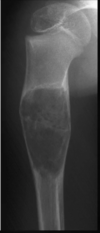
Medullary (centric)
This lesion would be considered ____-based
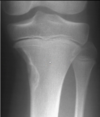
Cortical (eccentric)

This lesion would be considered ____-based

Periosteal

This lesion would be consider ____-based

Extraosseus

The shape of this lesion would be described how

Pedunculated Exostosis (think of broccoli)

The shape of this lesion would be described how

Sessile Exostosis

What is shown here?
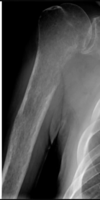
Poorly defined margination

What is shown here?

Well defined margination

What is shown here?

Cortical Thinning
(also well-defined lesion)
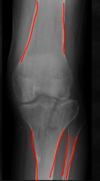
What is shown here?

Cortical Thickening

What is shown here in regards to cortex?

Cortical Expansion with cortical interupption

What is shown here?

Cortical Destruction

_____ are usually used to describe decreased focal density due to aggressive lesions
Osteolytic (aka permeative/motheaten)
_____ are usually used to describe decreased focal density due to benign lesions
Lucent (aka geographic or soap bubbly)
What lesion is shown here in regards to density?

Lucent (aka geographic)

What is shown here in regards to density?

Soap Bubble (lucent, well-defined)

What is seen here in regards to density?
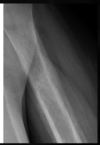
Peremeative/Motheaten (osteolytic)

What is seen here in regards to density?

Permeative/Motheaten

What is seen here in regards to density? (left is abnormal)
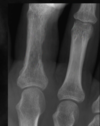
Permeative/Motheaten
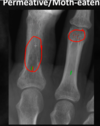
_____ are usually used to describe increased focal density due to aggressive lesions
Osteoblastic
_____ are usually used to describe increased focal density due to benign lesions
Sclerotic
What is seen here in regards to density?

Osteoblastic (large zone of transition, ill defined)

What is seen here in regards to density?

Sclerotic

What is seen here in regards to density?

Mixed (osteoblastic & osteolytic)
What are the 5 different types of matrixes?
Fat
Cartilage
Bone
Fibrous
Cystic/Fluid
What is seen here in regards to matrix?

Fat Matrix - bone

What is seen here in regards to matrix?
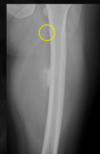
Fat matrix - soft tissue (periosteal reaction in orange)
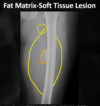
Focal, small spots in cartilaginous matrix is referred to as ____
Stippled
What is seen here in regards to matrix?
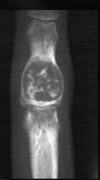
Stippled calcification in cartilaginous matrix

Larger, variable size & density, confluence of stippled Ca++ is referred to as ____
Flocculent
Thin, curvilinear Ca++, typically seen in aggressive leasions referred to as ____
Arc & ring
What is seen here in regards to matrix?

Flocculent calcification - cartilage matrix

What is seen here in regards to matrix?

Arc & ring - cartilage matrix (laterally)

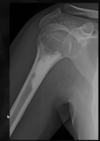
Osseous Matrix (sclerotic benign tumor)

“Ground glass” appearance is associated with a lesion in the ____ matrix
Fibrous matrix
What is seen here in regards to matrix?

Fibrous Matrix - Ground glass (smoky)

What is seen here in regards to matrix?

Cystic Matrix

What are the 4 categories of periosteal reactions from least to most aggressive?
Solid
Laminated
Spiculated
Codmans triangle
What is seen here in regards to periosteal reaction?
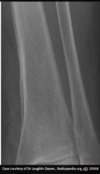
Solid - single layer

What is seen here in regards to periosteal reaction?
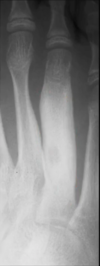
Solid - cortical thickening

What is seen here in regards to periosteal reaction?

Sold - irregular single layer

What is seen here in regards to periosteal reaction?

Laminated

In a stipulated periosteal reaction, ____ refers to lesion perpendicular to cortex & _____ refers to lesion radiating from a point source
Hair-on-end
Sunburst
What is seen here in regards to periosteal reaction?

Spiculated - hair on end

What is seen here in regards to periosteal reaction?

Spiculated - hair on end

What is seen here in regards to periosteal reaction?

Spiculated - sunburst

What is seen here in regards to periosteal reaction?
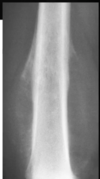
Codmans triangle

What is seen here in regards to soft tissue changes?

Water density

What is seen here in regards to soft tissue changes?

Fat density
What is seen here in regards to soft tissue changes?

Calcific density

What is seen here in regards to soft tissue changes?
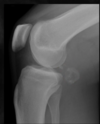
Ossific Density

How would you describe the left vs. right image in regards to number of lesions?

Monostotic
Polyostotic

Long zone of transition
Permeative or motheaten appearence
Cortical destruction
Solid, lamined, or spiculated periosteal reaction
Codmans triangle
Soft tissue involvement/mass
These are characteristics of ____ (benign/aggressive) lesions
Aggressive
Short zone of transition
Cortical thinning
Cortical expansion w/o destruction
Sclerotic rim or peripheral sclerosis
Solid or periosteal reaction
Lesion size stable
These are characteristics of ____ (benign/aggressive) lesions
Benign
Describe this lesion in location, density, cortical & overall appearence
Aggressive or benign?

Distal tibial (lateral) metaphysis
Lucent, thin rim of sclerosis
Eccentrically located, cortically based
Cortical thinning & expansion
Soap bubble appearence
Benign

Describe this lesion in location, density, cortical & overall appearence
Aggressive or benign?

Distal Diaphysis/Metaphysis
Motheaten/Permeative
Long zone of transition
Ill-defined lucencies, cortical destruction
Periosteal reactions
Soft Tissue mass
Aggressive

Describe location of lesion, ____-based

Intertrochanteric
Medullary-based
The following lesion is ____ based

Eccentrically, cortical-based

Descibe location of lesion

2nd Distal Phalange

Describe shape of lesion

Pedunculated exostosis
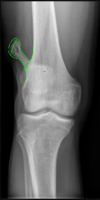
Describe the margination of the following lesion

Sharply marginated, well defined lesion


